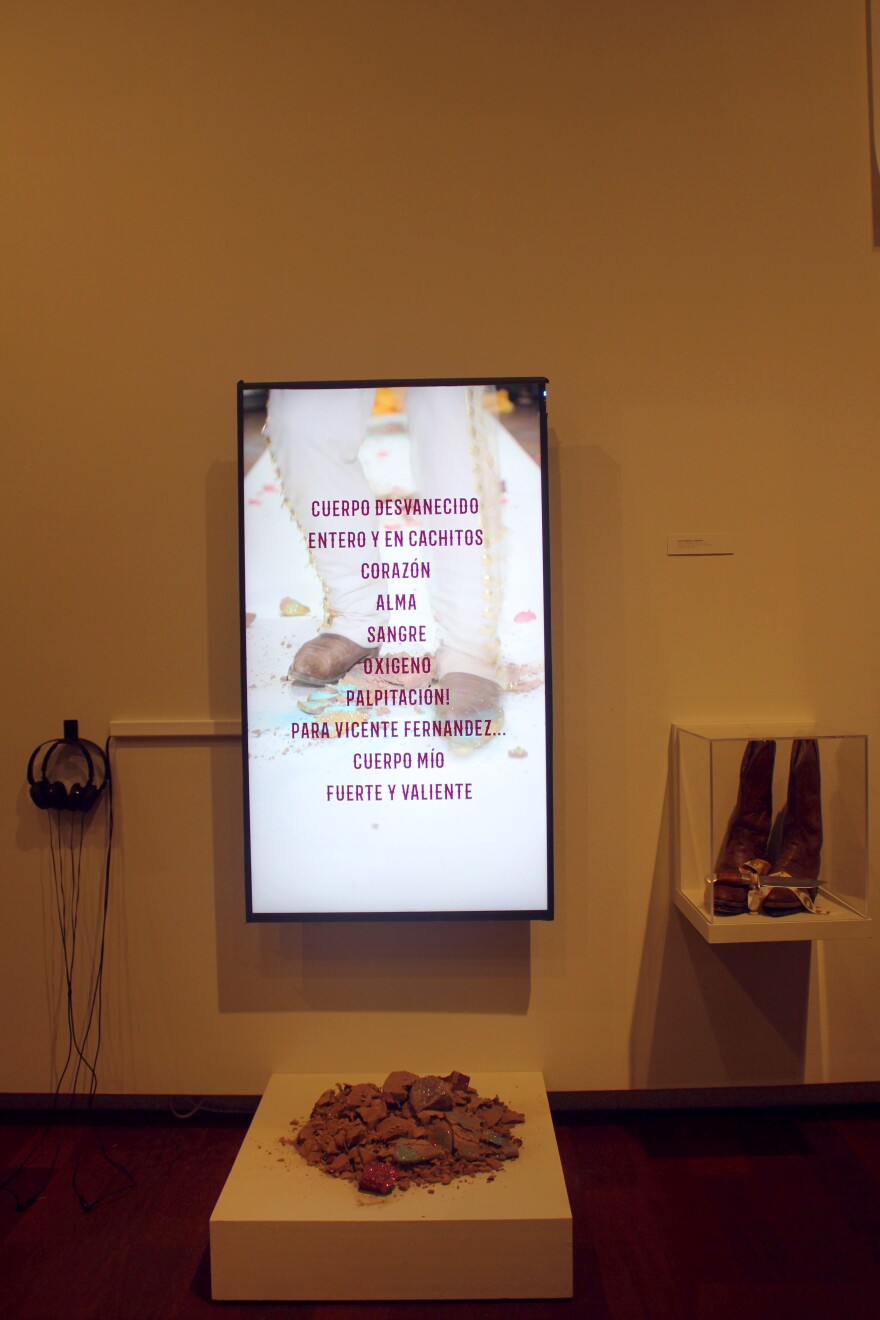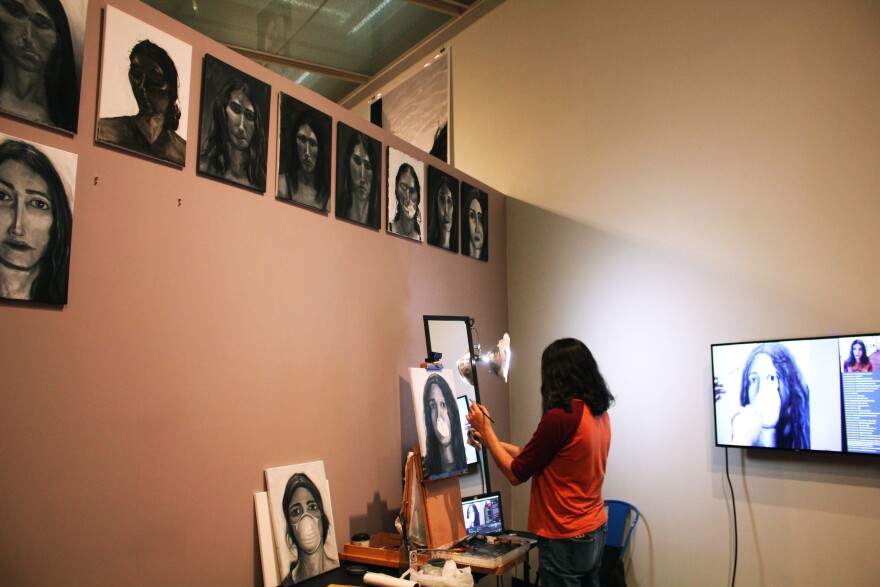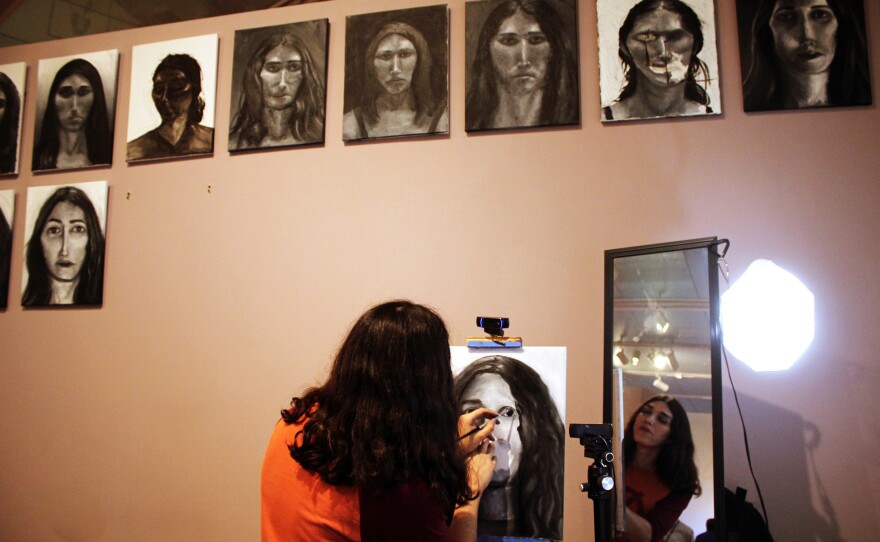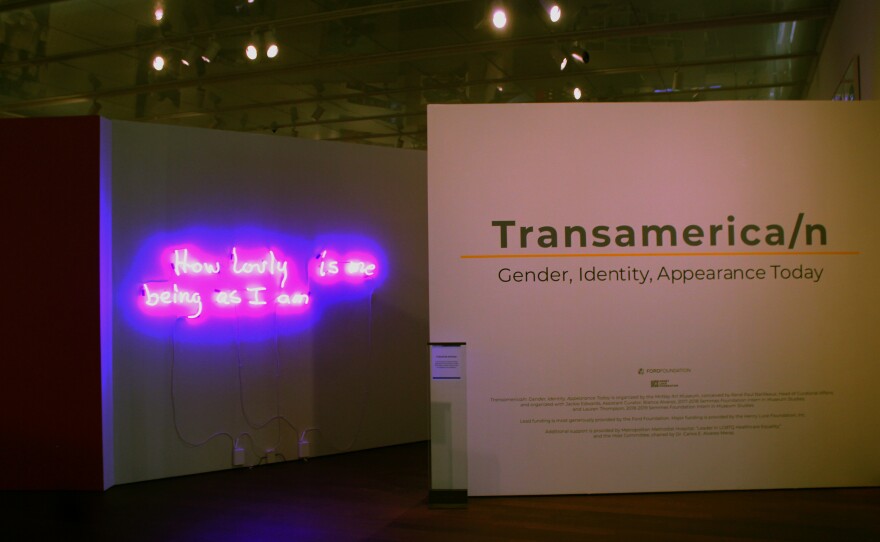This summer marks the 50th anniversary of the Stonewall Riots, when members of the queer community in New York City clashed with cops in protest of anti-gay raids and police brutality. In commemoration of the anniversary, San Antonio’s McNay Art Museum is featuring works that explore gender identity.
The exhibit is open until Sept. 15. Ticket information can be found here.
After passing more than 120 portraits of Andy Warhol’s famous friends, visitors to the McNay Art Museum enter a second exhibit called Transamerica/n: Gender, Identity, Appearance Today. It is one of the United States’ first comprehensive exhibitions of North American art that explores gender identity.
Fragile Soles
A white mariachi outfit sat at the center of the exhibit’s first room. Behind it was a video screen showing a man wearing the outfit and a pair of cowboy boots.

That man was San Antonio-based artist Jose Villalobos. The video was overlaid with text — a poem.
It’s about Vicente Fernandez, a prominent Mexican musician who made homophobic statements after being diagnosed with liver cancer. He refused a liver transplant because he was afraid it could come from a gay man.

The piece was called Fragile Soles — a play on words. In the video, Villalobos violently stomped on clay shaped like the sole of a cowboy boot. The clay shards and boots were on display next to the video screen.
Villalobos grew up in El Paso, where he first encountered men who he said put on a macho performance every time they left the house.
“I would just notice that when a male puts on the cowboy hat, the belts and the boots, he becomes like a totally different person — it’s like an alpha. It’s kind of, ‘I wear the pants, and I’m the tough guy,’” Villalobos said. “A lot of that is stuff I would just see growing up. The attitude changes from them being in the comfort of their own home, and then when they step outside of their home in all this getup, they’re putting on a performance of ‘I’m macho.’”
The white mariachi outfit and cowboy boots symbolize contrived masculinity.
At the end of the performance, Villalobos pulled out a cow’s liver, stabbed it, and stained his pure-white mariachi outfit with blood.
“A lot of it talks about the pureness of what it is to be a man in a household — especially a Latino household,” Villalobos said.
Hello World
Just past the mariachi outfit was another San Antonio-based artist whose contribution was ongoing. This summer, Nicki Lucio spent most days at the McNay in front of a canvas, a mirror and a camera, which livestreamed her work.

Over the years, Lucio has grappled with self-image.
“As a transgender, I have lots of self-loathing, self-esteem, and, frankly, self-hatred. I wouldn’t even look in mirrors a few years ago. I just would outright avoid them,” Lucio said. “I would always have these incredibly emotional responses to myself when I was forced to do self-portrait work when I was going through my BFA.”
To explore those emotional reactions, Lucio challenged herself to make a self-portrait every day. And then she took up that battle in public.
The day-to-day confrontation played out on the wall above Lucio. Her black-and-white self-portraits were hung in chronological order. Some were beautiful, created when Lucio saw herself in the best light, and all were honest.
“There are days where I will fall apart,” Lucio said. “One of these pictures is absolutely destroyed. That happened on camera with people watching.”
As she painted self-portraits, Lucio switched from in-person interactions with museum visitors to online conversations in the livestream chat. Exploring fluid self-image while crossing boundaries between physical and digital spaces, Hello World got at the heart of Transamerica/n.
“The title Transamerica/n refers both to transgender identity but also talks about or is thinking about movement,” said Rene Barrielleux, the head of curatorial affairs at the McNay. “Things that are crossing or that are moving from one space to another — the way that we move physically in space but also move mentally in space, and the ways that artists often reflect all this different kind of movement in their work.”
PRIDE IS NOT ENOUGH
Behind Lucio stood a McNay security guard who was also an artist. After visitors walked past Lucio and the security guard, whose name is Michael Martinez, they viewed 72 bricks skewered by 12 vertical steel pipes. A wall of mirrors forced visitors to face themselves as they looked at Martinez’s work, titled PRIDE IS NOT ENOUGH.

“Now the number of the bricks is significant as well because 49 of the 72 bricks account for the 49 victims of the Pulse nightclub massacre, and the other 23 account for the victims of anti-transgender violence in the U.S. in 2018,” Martinez said.
By the time Martinez began construction of the piece, that number had increased to more than two dozen. According to the Human Rights Campaign, since 2013, 80% of anti-transgender murder victims were people of color — a statistic that informed Martinez’s work.
The piece conveyed a pointed question about Pride: “Where is the space for black queers on the podium or at the forefront of the parade?” Martinez asked.
The 72 bricks were from the Denver Heights neighborhood on the East Side of San Antonio. They referred to Marsha P. Johnson, a gay rights advocate and black transgender woman who some say threw the first brick during the 1969 Stonewall Riots. A year after Stonewall, the first gay pride parades were held in the U.S.
Martinez, Lucio and Villalobos were three of ten San Antonio-based artists featured in the exhibition — an unusually large amount of local talent for a major exhibit, according to the McNay. Transamerica/n also featured works by 47 out-of-town artists, including Julio Galán, Andy Warhol, Lesley Dill, Jacolby Satterwhite, Carlos Betancourt and Greer Lankton.
Martinez hoped Transamerica/n will move members of the San Antonio LGBT community closer to the San Antonio art community.
“There’s all this beautiful art that’s out there and this beautiful community that we need to be more present in,” Martinez said. “So yeah, get out there — out of the closet and into the gallery, into the streets.”
Dominic Anthony Walsh can be reached at Dominic@TPR.org




